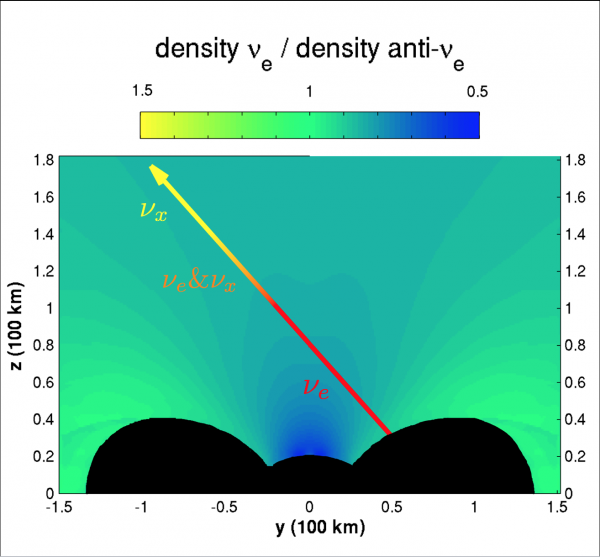Neutrinos are a necessary component of the physics of several phenomena associated with neutron star merger remnants, examples include nucleosynthesis and jet production in gamma-ray

bursts. Many essential neutrino interactions are dependent on neutrino flavor so that an understanding of the flavor content of the neutrinos is critical for providing an accurate picture of merger phenomena.
Once neutrinos are emitted from hot, dense astrophysical objects, they can change their flavor through neutrino oscillations. In the last few years, it has become apparent that many interesting oscillation effects occur in environments with large numbers of neutrinos. In particular, neutrinos may experience collective neutrino oscillations in supernovae [1], and possibly in compact binary mergers. In merger remnant environments, it has been suggested that neutrinos can undergo not only the same type of flavor transformations as in supernova scenarios but also a novel type of transition called matter-neutrino resonance (MNR) transitions [2].
A collaboration led by NC State graduate student Yong-Lin Zhu along with TU Darmstadt researcher Albino Perego and JINA-CEE member Gail McLaughlin performed a study of MNR transitions using the results of a dynamically evolved detailed three-dimensional, Newtonian simulation of the aftermath of a binary neutron star merger under the influence of neutrino cooling and heating. This is the first calculation that has used self-consistent neutrino and matter distributions from the same dynamical simulation.
They found that neutrinos typically pass through a resonance location at the edge of the low-density funnel above the massive neutron star where the neutrino and matter potentials have the approximately the same magnitude. Thus many neutrinos emitted from the massive neutron star have the opportunity to encounter an MNR. The type of MNR transition varies between neutrino trajectories, but in most cases, at the end of the MNR transition(s), the electron neutrinos have completely converted to mu or tau-type neutrinos, whereas the electron antineutrinos experience an oscillation but then return to their original configuration.
Future studies of MNR transitions in binary neutron star merger remnants are needed to elucidate the consequences of these transitions, as well as to further probe the efficacy of the MNR transition itself. These results have implications for various nucleosynthesis scenarios as from collisionally heated material as well as neutrino-driven winds. Additionally, if a merger were to occur within the range of current or future neutrino detectors, the flavor dependent neutrino signal will provide a wealth of information about these objects.
Researchers: Yong-Lin Zhu (NC State), Albino Perego (TU Darmstadt), Gail C. McLaughlin (NC State)
Further reading:
[1]Duan, H., Fuller, G.M. and Qian, Y.Z., 2006. Physical Review D, 74(12), p.123004.
[2]Malkus, A., Kneller, J.P., McLaughlin, G.C. and Surman, R., 2012. Physical Review D, 86(8), p.085015.
This work was published (highlighted as editor’s suggestion) as:
Zhu, Y.L., Perego, A. and McLaughlin, G.C., 2016. Physical Review D, 94(10), p.105006.
